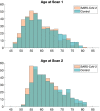SARS-CoV-2 is associated with changes in brain structure in UK Biobank
- PMID: 35255491
- PMCID: PMC9046077
- DOI: 10.1038/s41586-022-04569-5
SARS-CoV-2 is associated with changes in brain structure in UK Biobank
Abstract
There is strong evidence of brain-related abnormalities in COVID-191-13. However, it remains unknown whether the impact of SARS-CoV-2 infection can be detected in milder cases, and whether this can reveal possible mechanisms contributing to brain pathology. Here we investigated brain changes in 785 participants of UK Biobank (aged 51-81 years) who were imaged twice using magnetic resonance imaging, including 401 cases who tested positive for infection with SARS-CoV-2 between their two scans-with 141 days on average separating their diagnosis and the second scan-as well as 384 controls. The availability of pre-infection imaging data reduces the likelihood of pre-existing risk factors being misinterpreted as disease effects. We identified significant longitudinal effects when comparing the two groups, including (1) a greater reduction in grey matter thickness and tissue contrast in the orbitofrontal cortex and parahippocampal gyrus; (2) greater changes in markers of tissue damage in regions that are functionally connected to the primary olfactory cortex; and (3) a greater reduction in global brain size in the SARS-CoV-2 cases. The participants who were infected with SARS-CoV-2 also showed on average a greater cognitive decline between the two time points. Importantly, these imaging and cognitive longitudinal effects were still observed after excluding the 15 patients who had been hospitalised. These mainly limbic brain imaging results may be the in vivo hallmarks of a degenerative spread of the disease through olfactory pathways, of neuroinflammatory events, or of the loss of sensory input due to anosmia. Whether this deleterious effect can be partially reversed, or whether these effects will persist in the long term, remains to be investigated with additional follow-up.
© 2022. The Author(s).
Conflict of interest statement
R.C. has been seconded from the University of Oxford as chief executive and principal investigator of UK Biobank, which is a charitable company. N.A. is chief scientist for UK Biobank. P.M.M. acknowledges consultancy fees from Novartis and Biogen; he has received recent honoraria or speakers’ honoraria and research or educational funds from Novartis, Bristol Myers Squibb and Biogen. P.M.M. serves as the honorary chair of the UK Biobank Imaging Working Group and as an unpaid member of the UK Biobank Steering Committee; he is chair of the UKRI Medical Research Council Neurosciences and Mental Health Board.
Figures









Update of
-
SARS-CoV-2 is associated with changes in brain structure in UK Biobank.medRxiv [Preprint]. 2022 Mar 2:2021.06.11.21258690. doi: 10.1101/2021.06.11.21258690. medRxiv. 2022. Update in: Nature. 2022 Apr;604(7907):697-707. doi: 10.1038/s41586-022-04569-5. PMID: 34189535 Free PMC article. Updated. Preprint.
Comment in
-
Brain changes after COVID revealed by imaging.Nature. 2022 Apr;604(7907):633-634. doi: 10.1038/d41586-022-00503-x. Nature. 2022. PMID: 35260835 No abstract available.
-
Brain changes after COVID-19 - how concerned should we be?Nat Rev Neurol. 2022 Jun;18(6):321-322. doi: 10.1038/s41582-022-00661-6. Nat Rev Neurol. 2022. PMID: 35449462 Free PMC article.
-
COVID and smell loss: answers begin to emerge.Nature. 2022 Jun;606(7915):631-632. doi: 10.1038/d41586-022-01589-z. Nature. 2022. PMID: 35681006 No abstract available.
-
SARS-CoV-2 infection and the brain: direct evidence for brain changes in milder cases.Signal Transduct Target Ther. 2022 Jul 11;7(1):230. doi: 10.1038/s41392-022-01072-1. Signal Transduct Target Ther. 2022. PMID: 35817774 Free PMC article. No abstract available.
References
MeSH terms
Grants and funding
- MR/T033371/1/MRC_/Medical Research Council/United Kingdom
- MC_QA137853/MRC_/Medical Research Council/United Kingdom
- ZIA MH002781/ImNIH/Intramural NIH HHS/United States
- MR/K006673/1/MRC_/Medical Research Council/United Kingdom
- MC_PC_17228/MRC_/Medical Research Council/United Kingdom
- ZIA MH002782/ImNIH/Intramural NIH HHS/United States
- MR/S034978/1/MRC_/Medical Research Council/United Kingdom
- MC_PC_15067/MRC_/Medical Research Council/United Kingdom
- MC_PC_17223/MRC_/Medical Research Council/United Kingdom
- CH/1996001/9454/BHF_/British Heart Foundation/United Kingdom
- MC_PC_12027/MRC_/Medical Research Council/United Kingdom
- 203139/Z/16/Z/WT_/Wellcome Trust/United Kingdom
- 215573/Z/19/Z/WT_/Wellcome Trust/United Kingdom
- MC_EX_G0801669/MRC_/Medical Research Council/United Kingdom
- MC_PC_21051/MRC_/Medical Research Council/United Kingdom
- MC_U137686854/MRC_/Medical Research Council/United Kingdom
- MC_PC_12029/MRC_/Medical Research Council/United Kingdom
- G0300622/MRC_/Medical Research Council/United Kingdom
- MC_PC_12028/MRC_/Medical Research Council/United Kingdom
- WT_/Wellcome Trust/United Kingdom
- MC_PC_18026/MRC_/Medical Research Council/United Kingdom
LinkOut - more resources
Full Text Sources
Other Literature Sources
Medical
Miscellaneous

